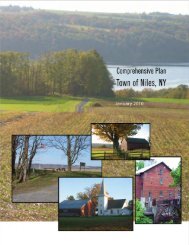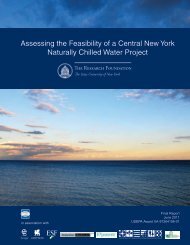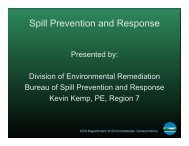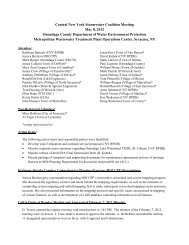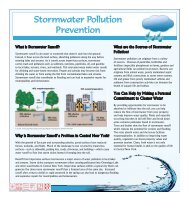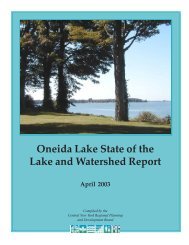A Management Strategy for Oneida Lake and its ... - CNY RPDB Home
A Management Strategy for Oneida Lake and its ... - CNY RPDB Home
A Management Strategy for Oneida Lake and its ... - CNY RPDB Home
Create successful ePaper yourself
Turn your PDF publications into a flip-book with our unique Google optimized e-Paper software.
Managing Flooding <strong>and</strong> Water Levels<br />
Program Goal<br />
The program goal is to provide water level management recommendations to minimize flood<br />
damage to properties along the <strong>Oneida</strong> <strong>Lake</strong> shoreline while maintaining levels that are<br />
beneficial <strong>and</strong> necessary <strong>for</strong> navigation, water-based recreation, fish <strong>and</strong> wildlife habitat, <strong>and</strong><br />
lake ecology. To accomplish this goal, the following objectives were developed: protect human<br />
life, health, property, <strong>and</strong> public services such as water, sewer <strong>and</strong> gas systems; reduce the<br />
intensity <strong>and</strong> duration of high water levels; minimize flood damage to existing flood control<br />
structures such as dams, levees, breakwalls, riprap, <strong>and</strong> other channel improvements; reduce<br />
flood damage to bridges, roads <strong>and</strong> culverts; protect aquatic resources from unnecessary impacts<br />
from flooding or dewatering; <strong>and</strong> manage water levels to encourage water-based recreation,<br />
maintain current fish <strong>and</strong> wildlife habitat, <strong>and</strong> protect the basic ecology of <strong>Oneida</strong> <strong>Lake</strong>.<br />
Additional in<strong>for</strong>mation compiled by this Working Group can be found in Appendix A.<br />
page 38<br />
Problem Identification<br />
There are many (frequently conflicting) uses<br />
of <strong>Oneida</strong> <strong>Lake</strong>. The question has been<br />
repeatedly debated whether water level<br />
management decisions should be made to<br />
facilitate tourism, recreation, fisheries <strong>and</strong><br />
wildlife habitat, commercial navigation, boat<br />
launch <strong>and</strong> marina profitability or, last but<br />
certainly not least, flood control. <strong>Lake</strong> water<br />
levels are perceived as either too high or too<br />
low, depending on different interest groups.<br />
Flooding occurs along the <strong>Oneida</strong> <strong>Lake</strong><br />
shoreline <strong>and</strong> in several areas throughout the<br />
watershed, often after major storm events or<br />
rapid winter thaws. Water level fluctuations<br />
on <strong>Oneida</strong> <strong>Lake</strong> <strong>and</strong> within <strong>its</strong> watershed are a<br />
naturally occurring phenomenon further<br />
exacerbated by human factors, which is a<br />
chronic concern along various portions of the<br />
lake shoreline. The majority of the high water<br />
levels occur during the spring runoff period<br />
when rains <strong>and</strong> melting snow result in runoff<br />
rates that exceed the combined storage <strong>and</strong><br />
outlet discharge capacity, resulting in rising<br />
water levels. The majority of the annual high<br />
water levels occur during the months of<br />
March, April <strong>and</strong> May. It is unusual to observe<br />
high water levels outside of the spring<br />
runoff period. Consequently, the impact<br />
associated with annual snowmelt runoff<br />
phenomenon is a driving <strong>for</strong>ce on high water<br />
levels observed on <strong>Oneida</strong> <strong>Lake</strong>.<br />
Many upstream <strong>and</strong> downstream factors<br />
contribute to lake shoreline flooding. The<br />
<strong>Oneida</strong> River downstream of the Caughdenoy<br />
Dam is also very flood prone <strong>and</strong> there is<br />
considerable development in the Horseshoe<br />
Isl<strong>and</strong> area that is susceptible to flooding.<br />
Flood damages to this area could potentially<br />
increase if high volumes of water were<br />
released to reduce flooding along the <strong>Oneida</strong><br />
<strong>Lake</strong> shoreline. The entire region is hydrologically<br />
connected. The upstream <strong>and</strong><br />
downstream areas <strong>and</strong> the impacts of water<br />
level management, there<strong>for</strong>e, need to be<br />
considered when any decisions are made <strong>for</strong><br />
<strong>Oneida</strong> <strong>Lake</strong>.<br />
Water levels have been historically observed<br />
<strong>and</strong> recorded on <strong>Oneida</strong> <strong>Lake</strong>. Water level<br />
fluctuation has continued with the construction<br />
of the New York State Barge Canal<br />
System, where levels have risen above <strong>and</strong><br />
fallen below desired levels due to natural<br />
hydrometeorological circumstances <strong>and</strong><br />
Chapter 3: Priority Areas



